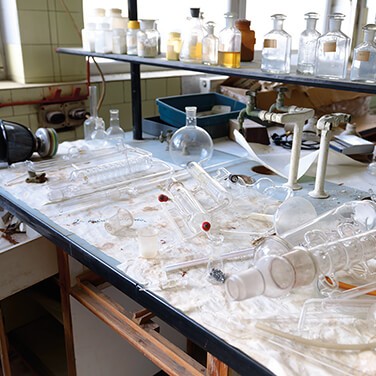Lessons from an Abandoned Lab
By Kylie Wolfe
We tend to think of science as something that’s always on an upward trajectory, inspiring progress and driving innovation. But some scientific centers, like the Amani Hill Research Station in Tanzania, have struggled to sustain their research efforts.
Throughout the 1950s, this lab was widely respected as a source of groundbreaking malaria research. Now vacant, it sits frozen in time. Stacks of paper with handwritten data sit abandoned on shelves, lab equipment on benches, and expired chemicals in cabinets. Even old diagrams of mosquitos have been left behind.
A Glimpse into the Past
Once a hub for scientific excellence in the jungles of East Africa, Amani employed 100 researchers searching for solutions to their country’s health problems. With this goal in mind, they hoped to pave the path to a bright future for African-led research teams — not only to inspire new ideas in science, but also to establish financial freedom and racial equality.
Even though the diseases they studied were more prominent in the lowlands, the facility was located at a high altitude in a remote area. This created a community large enough to sustain a post office, provide access to shopping, movies, and fresh milk, and offer recreational activities.
By 1977, foreign funding dried up as a result of political conflict. Labs like Amani started to become less of a focus, and throughout the 1990s, young researchers decided to travel abroad for positions in Western-led labs. As the Amani community fell apart and it became more costly to travel to study sites, they moved the lab two hours downhill. Now, only a small staff maintains the old location.
Insight for the Future
The story of Amani is not unusual, and it serves as a useful warning about the future of basic research. As government budget cuts threaten funding, private businesses are stepping in and pressuring researchers to support their corporate agendas in place of the researchers’ own. More and more labs are shifting away from solving long-term problems of inequality and climate change to focusing on “quick-fix” areas of study to avoid sacrificing their sources of funding.
As Paul Wenzel Geissler, a professor of social anthropology at the University of Oslo, says, “It’s entirely correct to look at places like Amani as a future for us all, if we allow infrastructure and basic research to be neglected and devalued.”
The Fate of Amani
Research in Africa is starting to boom again, but not without struggle. The government provides funding for employee salaries, but nothing beyond that. Increasingly, African labs rely on international organizations, universities, and philanthropy, but those sources often turn their attention to labs in the Western world instead.
In 2016, the Tanzanian Minister of Health announced her support to restore the Amani lab. It could become a university campus, a training center, or even a museum. But, for now, its exact fate remains uncertain.



